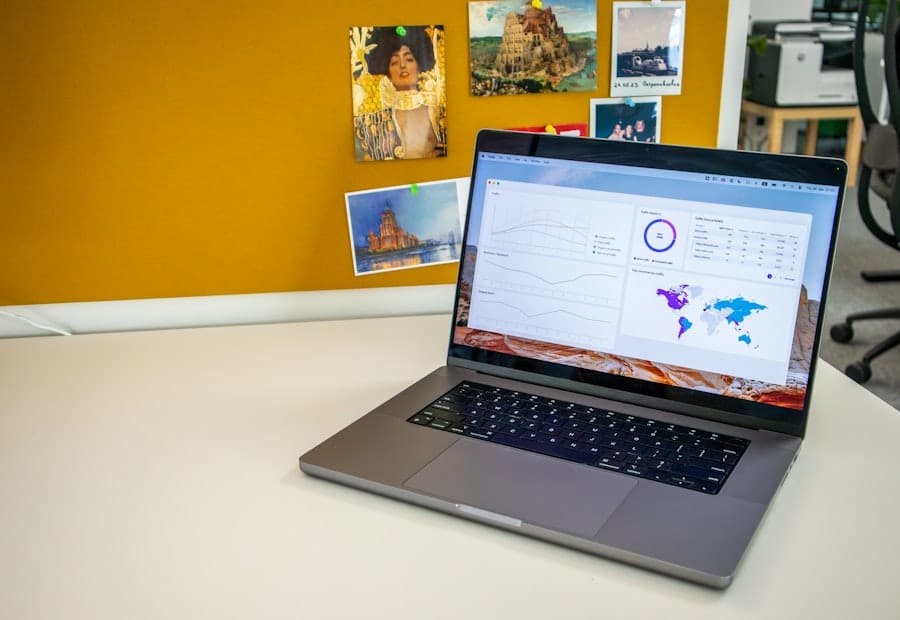In the realm of digital organization tools, Notion has emerged as a versatile platform that caters to a wide array of productivity needs. It combines note-taking, task management, and database functionalities into a single interface, making it an ideal choice for individuals and teams seeking to streamline their workflows. The ability to customize Notion to fit personal or organizational requirements is one of its most appealing features.
This adaptability allows users to create tailored productivity tracking systems that can evolve alongside their changing needs. Productivity tracking is essential for anyone looking to enhance their efficiency and effectiveness in both personal and professional contexts. By systematically monitoring tasks, goals, and progress, individuals can identify patterns in their work habits, recognize areas for improvement, and celebrate achievements.
Notion’s capabilities lend themselves well to this purpose, enabling users to create comprehensive systems that not only track daily activities but also provide insights into long-term productivity trends. This article will delve into the process of setting up a Notion workspace specifically designed for productivity tracking, offering practical guidance and tips along the way.
Key Takeaways
- Notion is a powerful tool for productivity tracking and organization
- Setting up your Notion workspace involves creating a dashboard and organizing your tasks
- Creating a daily productivity tracker template helps you plan and track your daily tasks
- Customizing your daily productivity tracker allows you to tailor it to your specific needs and preferences
- Adding tasks and goals to your tracker helps you stay focused and motivated to achieve them
Setting Up Your Notion Workspace
The first step in harnessing Notion for productivity tracking is to establish a well-organized workspace. Upon logging into Notion, users are greeted with a blank canvas that can be transformed into a personalized hub for all their productivity needs. The initial setup involves creating a new page dedicated to productivity tracking.
This page can serve as the central location where all related templates, databases, and notes are housed. To create an effective workspace, it is crucial to consider the structure and layout that will best support your workflow. Users can opt for a simple list format or a more complex database structure depending on their preferences.
For instance, a database can be set up to categorize tasks by project, priority level, or due date, allowing for easy filtering and sorting. Additionally, incorporating visual elements such as icons and cover images can enhance the aesthetic appeal of the workspace, making it more inviting and engaging. By thoughtfully organizing the workspace from the outset, users set the stage for a productive experience that encourages consistent tracking and reflection.
Creating a Daily Productivity Tracker Template

Once the workspace is established, the next step is to create a daily productivity tracker template. This template serves as the foundation for recording daily tasks, goals, and reflections. To begin crafting this template, users can start with a simple table format that includes essential columns such as “Task,” “Status,” “Priority,” “Time Spent,” and “Notes.” Each column serves a specific purpose: the “Task” column lists the activities to be completed, while the “Status” column allows users to indicate whether a task is pending, in progress, or completed.
In addition to these basic columns, users may want to incorporate fields for setting daily goals or intentions. For example, a “Goal” column can be added to outline what the user aims to achieve by the end of the day. This not only provides clarity but also fosters accountability.
Users can further enhance their template by including checkboxes for task completion or dropdown menus for selecting priority levels. By designing a comprehensive daily productivity tracker template, individuals create a structured approach to managing their time and tasks effectively.
Customizing Your Daily Productivity Tracker
Customization is one of Notion’s standout features, allowing users to tailor their daily productivity tracker to suit their unique preferences and workflows. Beyond the basic structure of the template, users can explore various formatting options to enhance usability and visual appeal. For instance, color-coding tasks based on priority can provide immediate visual cues about what needs attention first.
This simple yet effective technique helps users quickly assess their workload at a glance. Moreover, users can integrate additional elements such as progress bars or visual charts that represent task completion over time. By utilizing Notion’s database capabilities, users can create linked databases that connect their daily tracker with other relevant pages or projects within their workspace.
This interconnectedness allows for seamless navigation between different aspects of productivity tracking, making it easier to maintain focus on overarching goals while managing daily tasks. The ability to customize every aspect of the tracker ensures that it remains aligned with individual work styles and preferences.
Adding Tasks and Goals to Your Tracker
With the daily productivity tracker template in place and customized to fit personal needs, the next step involves populating it with tasks and goals. This process begins with identifying key responsibilities and objectives for each day. Users should consider both short-term tasks that need immediate attention and long-term goals that contribute to broader projects or aspirations.
By striking a balance between these two types of tasks, individuals can ensure that they are making progress on both daily responsibilities and larger ambitions. When adding tasks to the tracker, it is beneficial to break them down into manageable steps. For example, instead of listing “Complete project report” as a single task, users might break it down into smaller components such as “Research data,” “Draft introduction,” and “Compile findings.” This granular approach not only makes tasks feel less overwhelming but also provides opportunities for incremental progress throughout the day.
Additionally, setting specific deadlines for each task can enhance accountability and motivation, encouraging users to stay on track with their productivity goals.
Using Notion’s Features to Track Progress

Notion offers a plethora of features that can be leveraged to track progress effectively within the daily productivity tracker. One of the most powerful tools at users’ disposal is the ability to create linked databases that aggregate information from various pages within Notion. For instance, users can link their daily tracker with a project management database that outlines larger initiatives or milestones.
This interconnectedness allows for real-time updates on progress across multiple fronts. Another useful feature is the ability to utilize filters and views within databases. Users can create different views of their daily tracker based on specific criteria such as priority level or due date.
This functionality enables individuals to focus on what matters most at any given time without being overwhelmed by the entirety of their task list. Additionally, incorporating reminders or notifications within Notion can serve as gentle nudges to keep users accountable for completing tasks on time. By harnessing these features effectively, individuals can maintain a clear overview of their productivity journey while ensuring they remain aligned with their goals.
Analyzing and Reflecting on Your Productivity
Tracking productivity is not merely about recording tasks; it also involves analyzing data and reflecting on performance over time. Notion provides users with tools to facilitate this reflective practice by allowing them to visualize trends in their productivity patterns. For instance, users can create charts or graphs that illustrate task completion rates over weeks or months, providing valuable insights into periods of high productivity versus times when focus may have waned.
Reflection is an integral part of the productivity tracking process. At the end of each week or month, users should take time to review their completed tasks and assess whether they met their goals. Questions such as “What worked well?” and “What challenges did I face?” can guide this reflective process.
By identifying patterns in successes and obstacles, individuals can make informed adjustments to their workflows moving forward. This iterative approach not only enhances self-awareness but also fosters continuous improvement in productivity practices.
Tips for Maintaining Consistent Productivity Tracking
Maintaining consistent productivity tracking requires discipline and intentionality. One effective strategy is to establish a routine around using Notion for tracking purposes. For example, setting aside time each morning to plan out the day’s tasks or dedicating time at the end of each day for reflection can help solidify this practice into one’s daily rhythm.
Another tip is to keep the tracker simple and user-friendly. Overcomplicating the system with excessive features or convoluted structures can lead to frustration and disengagement over time.
Users should regularly evaluate their tracking system and make adjustments as needed based on what is working or not working for them. Additionally, integrating gamification elements—such as rewards for completing tasks or achieving goals—can add an element of fun and motivation to the tracking process. By implementing these strategies and leveraging Notion’s robust features effectively, individuals can cultivate a sustainable habit of productivity tracking that enhances both personal efficiency and overall satisfaction in achieving their goals.
If you’re interested in enhancing your productivity beyond just tracking your daily tasks, you might find it beneficial to explore tools that can help streamline your digital life. For instance, while building a daily productivity tracker in Notion can help organize your tasks, choosing the right technology to support your workflow is equally important. Consider reading this article on how to choose the right iPhone for you in 2023. It provides insights into selecting a device that complements your productivity needs, ensuring that your tech choices align with your organizational strategies.
FAQs
What is Notion?
Notion is a versatile productivity tool that allows users to create databases, take notes, manage projects, and more, all within a single platform.
What is a Daily Productivity Tracker?
A daily productivity tracker is a tool used to monitor and measure daily tasks, goals, and accomplishments in order to improve productivity and time management.
Why use Notion for a Daily Productivity Tracker?
Notion offers a customizable and flexible platform for creating and managing a daily productivity tracker, allowing users to tailor it to their specific needs and preferences.
How to create a Daily Productivity Tracker in Notion?
Creating a daily productivity tracker in Notion involves setting up a database, defining the categories and metrics to track, and designing a layout that suits your workflow.
What are the benefits of using a Daily Productivity Tracker?
A daily productivity tracker can help users stay organized, prioritize tasks, track progress, and identify areas for improvement in their daily routines and work habits.
Can a Daily Productivity Tracker in Notion be shared with others?
Yes, Notion allows users to share their productivity trackers with others, making it a useful tool for collaboration and team productivity tracking.

